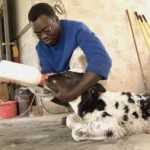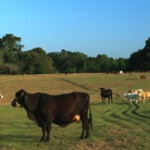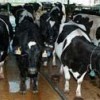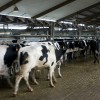 Virtually all Holstein dairy cows have the first wave of follicle growth starting two weeks postpartum, with about 30% of these cows ovulating within 21 days in milk. This 3-page fact sheet presents the results of a recent paper that evaluated the individual and combined effects of anovulation and subclinical endometritis on reproductive performance of dairy cows. Written by Klibs N. Galvão and Achilles Vieira-Neto, and published by the UF Department of Veterinary Medicine-Large Animal Clinical Sciences, May 2014.
Virtually all Holstein dairy cows have the first wave of follicle growth starting two weeks postpartum, with about 30% of these cows ovulating within 21 days in milk. This 3-page fact sheet presents the results of a recent paper that evaluated the individual and combined effects of anovulation and subclinical endometritis on reproductive performance of dairy cows. Written by Klibs N. Galvão and Achilles Vieira-Neto, and published by the UF Department of Veterinary Medicine-Large Animal Clinical Sciences, May 2014.
http://edis.ifas.ufl.edu/vm222
Tag: Dairy Reproduction
Can Maternal Colostrum Be Replaced by Commercial Products for Feeding Newborn Calves?
 Colostrum management and feeding are critical for calf health, calves’ future productive life, and farm profitability. Current recommendations state that a calf needs to ingest at least 150–200 g of immunoglobulin G within two hours of birth, but when colostrum quality is poor or unavailable, colostrum replacer may be a suitable alternative. This 3-page fact sheet presents the results of a recent publication that evaluated the effects of feeding maternal colostrum, one dose of plasma-derived colostrum replacer, or one dose of colostrum-derived colostrum replacer on serum total protein, immunoglobulin G concentration, calf morbidity, calf mortality, and weight gain from birth to weaning. Written by Klibs N. Galvao, and published by the UF Department of Veterinary Medicine-Large Animal Clinical Sciences, May 2014.
Colostrum management and feeding are critical for calf health, calves’ future productive life, and farm profitability. Current recommendations state that a calf needs to ingest at least 150–200 g of immunoglobulin G within two hours of birth, but when colostrum quality is poor or unavailable, colostrum replacer may be a suitable alternative. This 3-page fact sheet presents the results of a recent publication that evaluated the effects of feeding maternal colostrum, one dose of plasma-derived colostrum replacer, or one dose of colostrum-derived colostrum replacer on serum total protein, immunoglobulin G concentration, calf morbidity, calf mortality, and weight gain from birth to weaning. Written by Klibs N. Galvao, and published by the UF Department of Veterinary Medicine-Large Animal Clinical Sciences, May 2014.
http://edis.ifas.ufl.edu/vm196
What Is the Most Cost-Effective Breeding Program for Lactating Dairy Cows: Timed AI, Estrous Detection, or a Combination of Both?
 As any other business enterprise, the sustainability of a dairy farm is highly dependent on economics. Reproduction influences both milk production and number of replacement heifers available on a farm; therefore, reproductive efficiency becomes a key determinant of dairy cow profitability. Several parameters affect reproductive performance. This 4-page fact sheet presents information from recently published articles that looked at the economics of different reproductive programs for breeding dairy cows that use estrus detection only, timed AI only, or a combination of both. Written by Klibs N. Galvão, Gustavo M. Schuenemann, Eduardo S. Ribeiro, and Jose Eduardo P. Santos, and published by the UF Department of Veterinary Medicine-Large Animal Clinical Sciences, May 2014.
As any other business enterprise, the sustainability of a dairy farm is highly dependent on economics. Reproduction influences both milk production and number of replacement heifers available on a farm; therefore, reproductive efficiency becomes a key determinant of dairy cow profitability. Several parameters affect reproductive performance. This 4-page fact sheet presents information from recently published articles that looked at the economics of different reproductive programs for breeding dairy cows that use estrus detection only, timed AI only, or a combination of both. Written by Klibs N. Galvão, Gustavo M. Schuenemann, Eduardo S. Ribeiro, and Jose Eduardo P. Santos, and published by the UF Department of Veterinary Medicine-Large Animal Clinical Sciences, May 2014.
http://edis.ifas.ufl.edu/vm198
What Is the Most Cost-Effective Breeding Program for Breeding Heifers: Timed AI, Estrous Detection, or a Combination of Both?
 As any other business enterprise, the sustainability of a dairy farm is highly dependent on economics. In order to obtain a profitable return on assets, there is a constant need to maximize outputs and, oftentimes, to minimize inputs. Reproduction influences both milk production and number of replacement heifers available on a farm; therefore, reproductive efficiency becomes a key determinant of dairy cow profitability. This 3-page fact sheet presents information from recently published work that looked at the economics of different reproductive programs for breeding heifers that use timed AI only, estrus detection only, or a combination of both. Written by Klibs N. Galvão, Eduardo S. Ribeiro, and Jose Eduardo P. Santos, and published by the UF Department of Veterinary Medicine-Large Animal Clinical Sciences, May 2014.
As any other business enterprise, the sustainability of a dairy farm is highly dependent on economics. In order to obtain a profitable return on assets, there is a constant need to maximize outputs and, oftentimes, to minimize inputs. Reproduction influences both milk production and number of replacement heifers available on a farm; therefore, reproductive efficiency becomes a key determinant of dairy cow profitability. This 3-page fact sheet presents information from recently published work that looked at the economics of different reproductive programs for breeding heifers that use timed AI only, estrus detection only, or a combination of both. Written by Klibs N. Galvão, Eduardo S. Ribeiro, and Jose Eduardo P. Santos, and published by the UF Department of Veterinary Medicine-Large Animal Clinical Sciences, May 2014.
http://edis.ifas.ufl.edu/vm199
Can GnRH Be Used to Induce Ovulation Early in Lactation and Improve Fertility in Dairy Cows?
 It is well established that early cyclicity results in increased pregnancy per artificial insemination and decreased time to pregnancy. But none of the previous studies has used synchronization programs such as the Presynch-Ovsynch as part of their reproductive management. This 2-page fact sheet presents the results of a recent paper that evaluated the effects of administration of GnRH at 17 ± 3 and 20 ± 3 DIM in Holstein dairy cows without a corpus luteum (CL) on induction of ovulation, uterine health, and reproductive outcomes. Written by Klibs N. Galvão, and published by the UF Department of Veterinary Medicine-Large Animal Clinical Sciences, July 2014.
It is well established that early cyclicity results in increased pregnancy per artificial insemination and decreased time to pregnancy. But none of the previous studies has used synchronization programs such as the Presynch-Ovsynch as part of their reproductive management. This 2-page fact sheet presents the results of a recent paper that evaluated the effects of administration of GnRH at 17 ± 3 and 20 ± 3 DIM in Holstein dairy cows without a corpus luteum (CL) on induction of ovulation, uterine health, and reproductive outcomes. Written by Klibs N. Galvão, and published by the UF Department of Veterinary Medicine-Large Animal Clinical Sciences, July 2014.
http://edis.ifas.ufl.edu/vm201
When Should We Stop Breeding Dairy Cows?
 The decision of when to start and when to stop breeding cows during a lactation is often a challenging one for dairy producers. This 3-page fact sheet presents practical rules on how to determine when to stop breeding Holstein dairy cows based on persistency of milk production and break-even point for milk production. Written by Klibs N. Galvão and Albert De Vries, and published by the UF Department of Veterinary Medicine-Large Animal Clinical Sciences, July 2014.
The decision of when to start and when to stop breeding cows during a lactation is often a challenging one for dairy producers. This 3-page fact sheet presents practical rules on how to determine when to stop breeding Holstein dairy cows based on persistency of milk production and break-even point for milk production. Written by Klibs N. Galvão and Albert De Vries, and published by the UF Department of Veterinary Medicine-Large Animal Clinical Sciences, July 2014.
http://edis.ifas.ufl.edu/vm202
Should You Breed Cows during the Summer in the Southeastern United States? An Economic Analysis of a Dairy Herd in Florida
 In the southeast United States, since dairy cows experience decreased reproductive performance during the hot and humid summers, some dairy farmers delay breeding until the cooler fall. But there is no economic data to support this practice. This 3-page fact sheet presents the results of a recent paper that evaluated the effects that delaying breeding during the summer has on cow performance and profitability in Florida. Written by Klibs N. Galvão and Albert De Vries, and published by the UF Department of Veterinary Medicine-Large Animal Clinical Sciences, July 2014.
In the southeast United States, since dairy cows experience decreased reproductive performance during the hot and humid summers, some dairy farmers delay breeding until the cooler fall. But there is no economic data to support this practice. This 3-page fact sheet presents the results of a recent paper that evaluated the effects that delaying breeding during the summer has on cow performance and profitability in Florida. Written by Klibs N. Galvão and Albert De Vries, and published by the UF Department of Veterinary Medicine-Large Animal Clinical Sciences, July 2014.
http://edis.ifas.ufl.edu/vm195
Is It Worth Switching from Natural Service to Artificial Insemination? A Comparison of Reproductive Performance and Profitability in Dairy Herds
 Reproductive efficiency is a key determinant of dairy cow profitability. A considerable portion of dairy producers in the United States still use NS in at least part of their breeding program. This 3-page fact sheet presents the results of papers that compared the reproductive performance and profitability of dairy cows submitted to natural service or a combination of timed AI and natural service. Written by Klibs N. Galvão, Eduardo S. Ribeiro, and Jose Eduardo P. Santos, and published by the UF Department of Veterinary Medicine-Large Animal Clinical Sciences, June 2014.
Reproductive efficiency is a key determinant of dairy cow profitability. A considerable portion of dairy producers in the United States still use NS in at least part of their breeding program. This 3-page fact sheet presents the results of papers that compared the reproductive performance and profitability of dairy cows submitted to natural service or a combination of timed AI and natural service. Written by Klibs N. Galvão, Eduardo S. Ribeiro, and Jose Eduardo P. Santos, and published by the UF Department of Veterinary Medicine-Large Animal Clinical Sciences, June 2014.
http://edis.ifas.ufl.edu/vm200
The Use and Economic Value of the 3K SNP Genomic Test for Calves on Dairy Farms (AN270)
 The availability of genomic tests is rapidly changing genetics in the dairy industry. AI companies have been using genomics to select AI sires. Now also commercial dairy producers can find value in testing their calves to help decide which ones to keep. This 5-page fact sheet was written by Albert De Vries, David T. Galligan, and John B. Cole, and published by the UF Department of Animal Science, September 2011.
The availability of genomic tests is rapidly changing genetics in the dairy industry. AI companies have been using genomics to select AI sires. Now also commercial dairy producers can find value in testing their calves to help decide which ones to keep. This 5-page fact sheet was written by Albert De Vries, David T. Galligan, and John B. Cole, and published by the UF Department of Animal Science, September 2011.
http://edis.ifas.ufl.edu/an270
Management of Reproduction in Dairy Herds with Natural Service or Timed Artificial Insemination (AN262)
 Both natural service and artificial insemination programs can work for managing reproduction on dairy farms. This 3-page fact sheet provides comparison of reproductive performance and economic considerations. Written by Fábio S. Lima, Albert De Vries, Carlos A. Risco, and José E.P. Santos, and published by the UF Department of Animal Science, June 2011. (UF/IFAS Photo: Thomas Wright)
Both natural service and artificial insemination programs can work for managing reproduction on dairy farms. This 3-page fact sheet provides comparison of reproductive performance and economic considerations. Written by Fábio S. Lima, Albert De Vries, Carlos A. Risco, and José E.P. Santos, and published by the UF Department of Animal Science, June 2011. (UF/IFAS Photo: Thomas Wright)
http://edis.ifas.ufl.edu/an262
AN242 Effect of Sexed Semen on Dairy Heifer Supply from 2006 to 2012
AN242, a 7-page illustrated fact sheet by Albert De Vries, describes the estimated impact of the use of sexed semen on the national dairy heifer supply. Includes references. Published by the UF Department of Animal Sciences, May 2010.
http://edis.ifas.ufl.edu/an242
AN214 The Economics of Sexed Semen in Dairy Heifers and Cows
AN214, a 13-page fact sheet by Albert De Vries, summarizes the recent literature on sexed semen
use in dairy heifers and cows and evaluates the economics of the use of sexed semen in heifers and cows. Includes references. Published by the UF Department of Animal Sciences, March 2009.
http://edis.ifas.ufl.edu/AN214